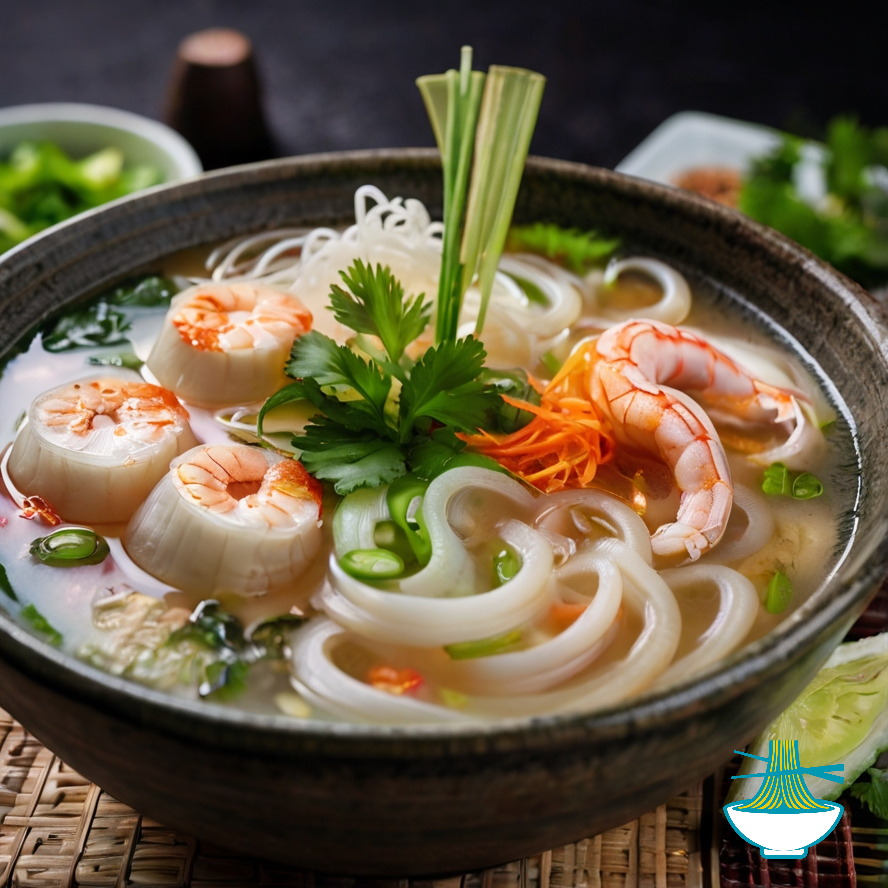Banh Canh is a Vietnamese dish known for its thick and chewy rice noodles, served in a flavorful broth with a variety of toppings such as seafood, pork, or chicken. The dish is popular in Vietnam and among Vietnamese communities worldwide.
Historically, Banh Canh has roots in Vietnamese culinary traditions, particularly in the southern regions where rice and rice-based dishes are staples. The noodles are made from a combination of rice flour and tapioca flour, giving them their distinctive texture. The toppings vary based on personal preference and regional variations, but common choices include shrimp, crab, pork slices, chicken, and sometimes fish cakes or quail eggs.
Banh Canh is often enjoyed as a comforting and hearty meal, perfect for both lunch and dinner. Its rich broth, coupled with the chewy noodles and flavorful toppings, makes it a favorite among noodle soup enthusiasts.
Ingredients:
- 500g thick rice noodles (Banh Canh noodles)
- 300g seafood (shrimp, crab, or a combination)
- 300g pork belly or chicken breast, sliced
- 1 liter chicken or seafood broth
- 2 tablespoons fish sauce
- 1 tablespoon sugar
- Salt to taste
- Chopped scallions and cilantro for garnish
- Optional: quail eggs, fish cakes, or other toppings of choice
Method of Preparation:
1. Boil the thick rice noodles according to package instructions until they are cooked but still slightly chewy. Drain and set aside.
2. In a pot, bring the chicken or seafood broth to a simmer. Add the sliced pork belly or chicken breast and cook until done.
3. Add the seafood (shrimp, crab, or a combination) to the broth and simmer until cooked through.
4. Season the broth with fish sauce, sugar, and salt to taste.
5. To serve, divide the cooked noodles into bowls. Ladle the hot broth with seafood and pork over the noodles.
6. Garnish with chopped scallions and cilantro.
7. Optionally, add quail eggs, fish cakes, or other toppings of your choice.
8. Serve hot and enjoy your comforting bowl of Banh Canh!
Nutrition Value:
1. 500g thick rice noodles (Banh Canh noodles):
- Calories: Approximately 1750 kcal
- Carbohydrates: Around 390g
- Protein: About 25g
- Fat: Minimal (less than 1g)
- Sodium: Varies based on brand, typically around 20mg
- Cholesterol: None
- Vitamins and Minerals: Provides carbohydrates for energy and a small amount of protein. Rice noodles are low in fat and cholesterol-free.
2. 300g seafood (shrimp, crab, or a combination):
- Calories: Approximately 200-250 kcal (varies based on type and preparation)
- Carbohydrates: Negligible
- Protein: Around 25-30g
- Fat: Varies, but generally low (less than 10g)
- Sodium: Varies based on preparation, typically around 200-300mg
- Cholesterol: Varies, but seafood is generally low in cholesterol
- Vitamins and Minerals: Rich in omega-3 fatty acids, vitamins B12 and D, and minerals like selenium and zinc. Seafood provides high-quality protein and is low in saturated fat.
3. 300g pork belly or chicken breast, sliced:
- Calories: Pork belly - Approximately 1500-1800 kcal; Chicken breast - Around 600-700 kcal
- Carbohydrates: Negligible in chicken breast; Pork belly contains minimal carbs
- Protein: Pork belly - About 20-25g; Chicken breast - Around 70-80g
- Fat: Pork belly - High in fat (around 120-150g); Chicken breast - Low in fat (5-10g)
- Sodium: Varies based on preparation, typically higher in pork belly
- Cholesterol: Pork belly - High cholesterol content; Chicken breast - Low cholesterol
- Vitamins and Minerals: Chicken breast is rich in lean protein, vitamins B6 and B12, niacin, and minerals like phosphorus and selenium. Pork belly provides energy from fat but is higher in saturated fat and cholesterol.
4. 1 liter chicken or seafood broth:
- Calories: Approximately 100-150 kcal (varies based on recipe and ingredients)
- Carbohydrates: Around 10-15g
- Protein: Around 5-10g
- Fat: Varies, but typically low (less than 5g)
- Sodium: Varies based on recipe, typically around 800-1000mg
- Cholesterol: Depends on broth ingredients, often low
- Vitamins and Minerals: Provides hydration, flavor, and nutrients depending on the ingredients used in the broth.
5. 2 tablespoons fish sauce:
- Calories: Approximately 20-30 kcal
- Carbohydrates: Around 3-5g
- Protein: About 2-3g
- Fat: Minimal (less than 1g)
- Sodium: High (around 2000-3000mg)
- Cholesterol: None
- Vitamins and Minerals: Contains essential amino acids and minerals like phosphorus and potassium. It adds savory flavor to dishes.
6. 1 tablespoon sugar:
- Calories: Around 50 kcal
- Carbohydrates: Approximately 12-13g
- Protein: Negligible
- Fat: None
- Sodium: None
- Cholesterol: None
- Vitamins and Minerals: Provides quick energy from carbohydrates but lacks significant nutritional value beyond calories.
7. Salt to taste:
- Calories: None
- Carbohydrates: None
- Protein: None
- Fat: None
- Sodium: Varies based on amount added
- Cholesterol: None
- Vitamins and Minerals: Adds flavor but should be used in moderation to control sodium intake.
8. Chopped scallions and cilantro for garnish:
- Calories: Minimal (less than 10 kcal per serving)
- Carbohydrates: Negligible
- Protein: Negligible
- Fat: Negligible
- Sodium: Low
- Cholesterol: None
- Vitamins and Minerals: Rich in vitamins A, C, and K, as well as antioxidants and minerals like potassium and manganese.
9. Optional: quail eggs, fish cakes, or other toppings of choice:
- Nutritional information varies based on the specific toppings chosen. Quail eggs are high in protein and various vitamins and minerals. Fish cakes may vary in nutritional content based on ingredients and preparation methods.


Comments